A Pressure-Impact Approach to Assess Contamination and Risk in Surface Water Bodies
Abstract
1. Introduction
2. Materials and Methods
2.1. Large-Scale Water Quality Model: RREA
2.2. Estimation of the Non-Compliance Load Methodology
2.3. Assessment of Confidence Level and Risk
3. Application to a Case Study
3.1. Description of the Study Area
3.2. Monitoring System in the Study Area
3.3. Implementation of the RREA Model in the Study Area
4. Results and Discussion
4.1. Analysis of the Chemical Status of Surface Water Bodies
4.2. Modeling the Chemical Status of Surface Water Bodies with RREA: Comparison with Data of the Monitoring System
4.3. Assessment of the Minimum Non-Compliance Load
4.4. Risk Analysis Based on Confidence Levels
5. Conclusions
Supplementary Materials
Author Contributions
Funding
Data Availability Statement
Conflicts of Interest
References
- UNESCO. The United Nations World Water Development Report 2021: Valuing Water; United Nations: New York, NY, USA, 2021. [Google Scholar]
- Sivaranjani, S.; Rakshit, A.; Singh, S. Water quality assessment with water quality indices. Int. J. Bioresour. Sci. 2015, 2, 85–94. [Google Scholar] [CrossRef]
- Risal, A.; Urfels, A.; Srinivasan, R.; Bayissa, Y.; Shrestha, N.; Paudel, G.P.; Krupnik, T.J. Impact of climate change on water resources and crop production in Western Nepal: Implications and adaptation strategies. Hydrology 2022, 9, 132. [Google Scholar] [CrossRef]
- Chen, L.; Xia, X.; Zhang, J.; Zhu, Y.; Long, C.; Chen, Y.; Guo, W.; Xu, L.; Jia, J. The food security risks in the Yangtze River Delta of China associated with water scarcity, grain production, and grain trade. Sci. Total Environ. 2024, 948, 174863. [Google Scholar] [CrossRef] [PubMed]
- Rajanayaka, C.; Weir, J.; Barkle, G.; Griffiths, G.; Hadfield, J. Assessing changes in nitrogen contamination in groundwater using water aging: Waikato River, New Zealand. J. Contam. Hydrol. 2020, 234, 103686. [Google Scholar] [CrossRef] [PubMed]
- Monico, V.; Solera, A.; Bergillos, R.J.; Paredes-Arquiola, J.; Andreu, J. Effects of environmental flows on hydrological alteration and reliability of water demands. Sci. Total Environ. 2022, 810, 151630. [Google Scholar] [CrossRef]
- Ghannem, S.; Bergillos, R.J.; Paredes-Arquiola, J.; Martínez-Capel, F.; Andreu, J. Coupling hydrological, habitat and water supply indicators to improve the management of environmental flows. Sci. Total Environ. 2023, 898, 165640. [Google Scholar] [CrossRef]
- Yi, J.; Gerbens-Leenes, P.W.; Aldaya, M.M. Crop grey water footprints in China: The impact of pesticides on water pollution. Sci. Total Environ. 2024, 935, 173464. [Google Scholar] [CrossRef]
- Shaika, N.A.; Khan, S.; Awal, S.; Haque, M.M.; Bashar, A.; Simsek, H. Aquatic Pollution in the Bay of Bengal: Impacts on Fisheries and Ecosystems. Hydrology 2025, 12, 191. [Google Scholar] [CrossRef]
- Kurrer, C.; Lipcaneanu, N. Water protection and management. In Fact Sheets on the European Union; Articles 191 to 193 of the Treaty on the Functioning of the European Union (TFEU); European Parliament: Strasbourg, France, 2023. [Google Scholar]
- Gartsiyanova, K.; Genchev, S.; Kitev, A. Assessment of Water Quality as a Key Component in the Water–Energy–Food Nexus. Hydrology 2024, 11, 36. [Google Scholar] [CrossRef]
- Directive 2000/60/EC of the European Parliament and of the Council. Establishing a Framework for Community Action in the Field of Water Policy; L327; Official Journal of the European Communities: Luxembourg, 2000; Volume 43.
- Carter, J.G.; White, I. Environmental planning and management in an age of uncertainty: The case of the Water Framework Directive. J. Environ. Manag. 2012, 113, 228–236. [Google Scholar] [CrossRef]
- Fliedner, A.; Lohmann, N.; Rüdel, H.; Teubner, D.; Wellmitz, J.; Koschorreck, J. Current levels and trends of selected EU Water Framework Directive priority substances in freshwater fish from the German environmental specimen bank. Environ. Pollut. 2016, 216, 866–876. [Google Scholar] [CrossRef] [PubMed]
- Fliedner, A.; Rüdel, H.; Lohmann, N.; Buchmeier, G.; Koschorreck, J. Biota monitoring under the Water Framework Directive: On tissue choice and fish species selection. Environ. Pollut. 2018, 235, 129–140. [Google Scholar] [CrossRef] [PubMed]
- Cooper, R.J.; Hiscock, K.M. Two decades of the EU Water Framework Directive: Evidence of success and failure from a lowland arable catchment (River Wensum, UK). Sci. Total Environ. 2023, 869, 161837. [Google Scholar] [CrossRef]
- Adams, R.; Quinn, P. Simulating phosphorus load reductions in a nested catchment using a flow pathway-based modeling approach. Hydrology 2023, 10, 184. [Google Scholar] [CrossRef]
- Pardo-Loaiza, J.; Solera, A.; Bergillos, R.J.; Paredes-Arquiola, J.; Andreu, J. Improving indicators of hydrological alteration in regulated and complex water resources systems: A case study in the Duero River basin. Water 2021, 13, 2676. [Google Scholar] [CrossRef]
- Pardo-Loaiza, J.; Bergillos, R.J.; Solera, A.; Paredes-Arquiola, J.; Andreu, J. Habitat alteration assessment for the management of environmental flows in regulated basins. J. Environ. Manag. 2022, 319, 115653. [Google Scholar] [CrossRef]
- Pardo-Loaiza, J.; Bergillos, R.J.; Solera, A.; Paredes-Arquiola, J.; Andreu, J. The role of environmental flows in the spatial variation of the water exploitation index. Water 2022, 14, 2938. [Google Scholar] [CrossRef]
- Li, Y.; Guo, R.; Liang, X.; Yao, B.; Yan, S.; Guo, Y.; Han, Y.; Cui, J. Pollution characteristics, ecological and health risks of herbicides in a drinking water source and its inflowing rivers in North China. Environ. Pollut. 2023, 334, 122130. [Google Scholar] [CrossRef]
- Bhatt, D.; Swain, M.; Yadav, D. Artificial intelligence based detection and control strategies for river water pollution: A comprehensive review. J. Contam. Hydrol. 2025, 271, 104541. [Google Scholar] [CrossRef]
- Hao, W.; Liu, Y.; Zhu, S.; Liu, Y.; Xu, W. Hydrological modeling of nutrient transport and mitigation strategies for non-point source pollution in the Bailin River basin. J. Contam. Hydrol. 2025, 273, 104617. [Google Scholar] [CrossRef] [PubMed]
- Chang, F.J.; Tsai, Y.H.; Chen, P.A.; Coynel, A.; Vachaud, G. Modeling water quality in an urban river using hydrological factors–Data driven approaches. J. Environ. Manag. 2015, 151, 87–96. [Google Scholar] [CrossRef]
- Chellaiah, C.; Anbalagan, S.; Swaminathan, D.; Chowdhury, S.; Kadhila, T.; Shopati, A.K.; Shangdiar, S.; Sharma, B.; Amesho, K.T. Integrating deep learning techniques for effective river water quality monitoring and management. J. Environ. Manag. 2024, 370, 122477. [Google Scholar] [CrossRef]
- Saadat, A.M.; Khodambashi Emami, S.; Hamidifar, H. A review on storage process models for improving water quality modeling in rivers. Hydrology 2024, 11, 187. [Google Scholar] [CrossRef]
- MARM. Orden ARM/2656/2008, de 10 de Septiembre, por la que se Aprueba la Instrucción de Planificación Hidrológica; 229, 22 September 2008; BOE núm: Madrid, Spain, 2008; pp. 38472–38582. [Google Scholar]
- Ejigu, M.T. Overview of water quality modeling. Cogent Eng. 2021, 8, 1891711. [Google Scholar] [CrossRef]
- Bouriqi, A.; Ouazzani, N.; Deliege, J.F. Modeling the Impact of Urban and Industrial Pollution on the Quality of Surface Water in Intermittent Rivers in a Semi-Arid Mediterranean Climate. Hydrology 2024, 11, 150. [Google Scholar] [CrossRef]
- De Girolamo, A.M.; Ricci, G.F.; Parete, G.; Gómez-Navarro, O.; Pérez, S.; Gentile, F. Modelling occurrence and environmental risk of azithromycin in an intermittent river: Applying hydrological and water quality models. J. Contam. Hydrol. 2025, 272, 104552. [Google Scholar] [CrossRef]
- Al-Jawad, J.Y.; Alsaffar, H.M.; Bertram, D.; Kalin, R.M. A comprehensive optimum integrated water resources management approach for multidisciplinary water resources management problems. J. Environ. Manag. 2019, 239, 211–224. [Google Scholar] [CrossRef]
- Mohtar, W.H.M.W.; Maulud, K.N.A.; Muhammad, N.S.; Sharil, S.; Yaseen, Z.M. Spatial and temporal risk quotient based river assessment for water resources management. Environ. Pollut. 2019, 248, 133–144. [Google Scholar] [CrossRef] [PubMed]
- Khorsandi, M.; Ashofteh, P.S.; Singh, V.P. Development of a multi-objective reservoir operation model for water quality-quantity management. J. Contam. Hydrol. 2024, 265, 104385. [Google Scholar] [CrossRef] [PubMed]
- Fischer, A.; Ter Laak, T.; Bronders, J.; Desmet, N.; Christoffels, E.; van Wezel, A.; van der Hoek, J.P. Decision support for water quality management of contaminants of emerging concern. J. Environ. Manag. 2017, 193, 360–372. [Google Scholar] [CrossRef]
- Van Vliet, M.T.; Flörke, M.; Harrison, J.A.; Hofstra, N.; Keller, V.; Ludwig, F.; Spanier, J.E.; Strokal, M.; Wada, Y.; Wen, Y.; et al. Model inter-comparison design for large-scale water quality models. Curr. Opin. Environ. Sustain. 2019, 36, 59–67. [Google Scholar] [CrossRef]
- Zhao, M.; Ma, C.; Zhang, H.; Li, H.; Huo, S. Long-term water quality simulation and driving factors identification within the watershed scale using machine learning. J. Contam. Hydrol. 2025, 273, 104604. [Google Scholar] [CrossRef] [PubMed]
- Whitehead, P.G.; Wilson, E.J.; Butterfield, D. A semi-distributed Integrated Nitrogen model for multiple source assessment in Catchments (INCA): Part I—Model structure and process equations. Sci. Total Environ. 1998, 210, 547–558. [Google Scholar] [CrossRef]
- Whitehead, P.G.; Wilson, E.J.; Butterfield, D.; Seed, K. A semi-distributed integrated flow and nitrogen model for multiple source assessment in catchments (INCA): Part II—Application to large river basins in south Wales and eastern England. Sci. Total Environ. 1998, 210, 559–583. [Google Scholar] [CrossRef]
- Wade, A.J.; Durand, P.; Beaujouan, V.; Wessel, W.W.; Raat, K.J.; Whitehead, P.G.; Butterfield, D.; Rankinen, K.; Lepisto, A. A nitrogen model for European catchments: INCA, new model structure and equations. Hydrol. Earth Syst. Sci. 2002, 6, 559–582. [Google Scholar] [CrossRef]
- Gomes, M.N., Jr.; Lago, C.A.F.D.; Castillo Rápalo, L.M.; Oliveira, P.T.S.; Giacomoni, M.H.; Mendiondo, E.M. HydroPol2D: Distributed hydrodynamic and water quality model-challenges and opportunities in poorly-gauged catchments. J. Hydrol. 2023, 625, 129982. [Google Scholar] [CrossRef]
- Strokal, M.; Kroeze, C.; Wang, M.; Bai, Z.; Ma, L. The MARINA model (Model to Assess River Inputs of Nutrients to seAs): Model description and results for China. Sci. Total Environ. 2016, 562, 869–888. [Google Scholar] [CrossRef]
- Andreu, J.; Capilla, J.; Sanchís, E. AQUATOOL, a generalized decision-support system for water-resources planning and operational management. J. Hydrol. 1996, 177, 269–291. [Google Scholar] [CrossRef]
- Paredes-Arquiola, J.; Andreu-Álvarez, J.; Martín-Monerris, M.; Solera, A. Water quantity and quality models applied to the Júcar River Basin, Spain. Water Resour. Manag. 2010, 24, 2759–2779. [Google Scholar] [CrossRef]
- Ghannem, S.; Paredes-Arquiola, J.; Bergillos, R.J.; Solera, A.; Andreu, J. Assessing the Effects of Environmental Flows on Water Quality for Urban Supply. Water 2024, 16, 1509. [Google Scholar] [CrossRef]
- Dorado-Guerra, D.Y.; Paredes-Arquiola, J.; Pérez-Martín, M.Á.; Tafur Hermann, H. Integrated Surface-Groundwater Modelling of Nitrate Concentration in Mediterranean Rivers, the Júcar River Basin District, Spain. Sustainability 2021, 13, 12835. [Google Scholar] [CrossRef]
- Dorado-Guerra, D.Y.; Paredes-Arquiola, J.; Pérez-Martín, M.Á.; Corzo-Pérez, G.; Ríos-Rojas, L. Effect of climate change on the water quality of Mediterranean rivers and alternatives to improve its status. J. Environ. Manag. 2023, 348, 119069. [Google Scholar] [CrossRef] [PubMed]
- Paredes-Arquiola, J. Manual Técnico del Modelo RREA: Respuesta Rápida del Estado Ambiental de las Masas de Agua Superficiales Continentales; Versión 4.0; Universitat Politécnica de Valencia: Valencia, Spain, 2023; pp. 1–4. [Google Scholar]
- CHJ, 2022. Plan Hidrológico de la Demarcación Hidrográfica del Júcar 2022–2027. Available online: https://www.chj.es/es-es/medioambiente/planificacionhidrologica/Paginas/PHC-2022-2027-Plan-Hidrologico-cuenca.aspx (accessed on 1 September 2025).
- European Food Safety Authority (EFSA); Brancato, A.; Brocca, D.; Cabrera, L.C.; De Lentdecker, C.; Erdos, Z.; Ferreira, L.; Greco, L.; Jarrah, S.; Kardassi, D.; et al. Updated review of the existing maximum residue levels for imazalil according to Article 12 of Regulation (EC) No 396/2005 following new toxicological information. EFSA J. 2018, 16, e05453. [Google Scholar] [CrossRef] [PubMed]
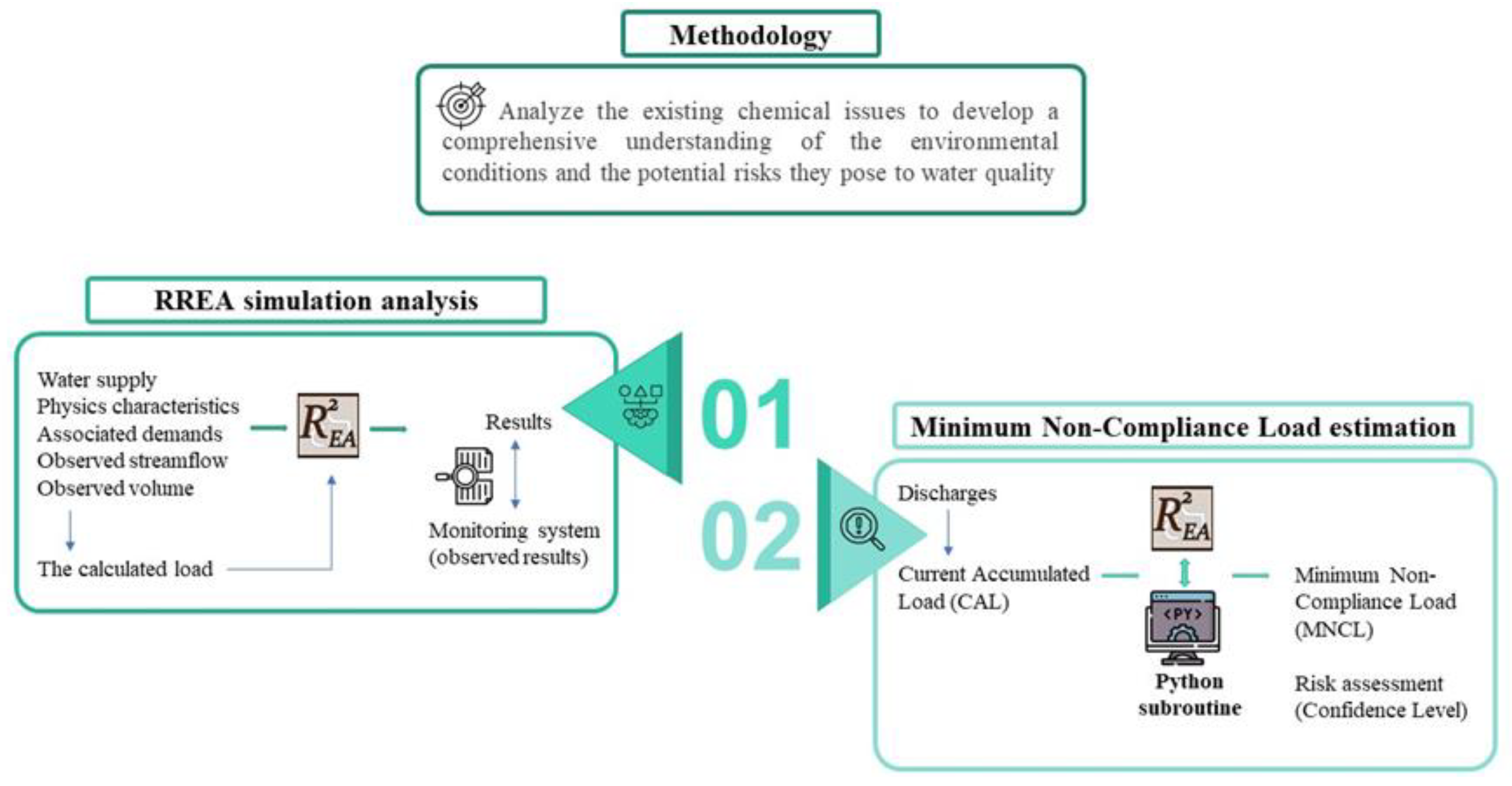

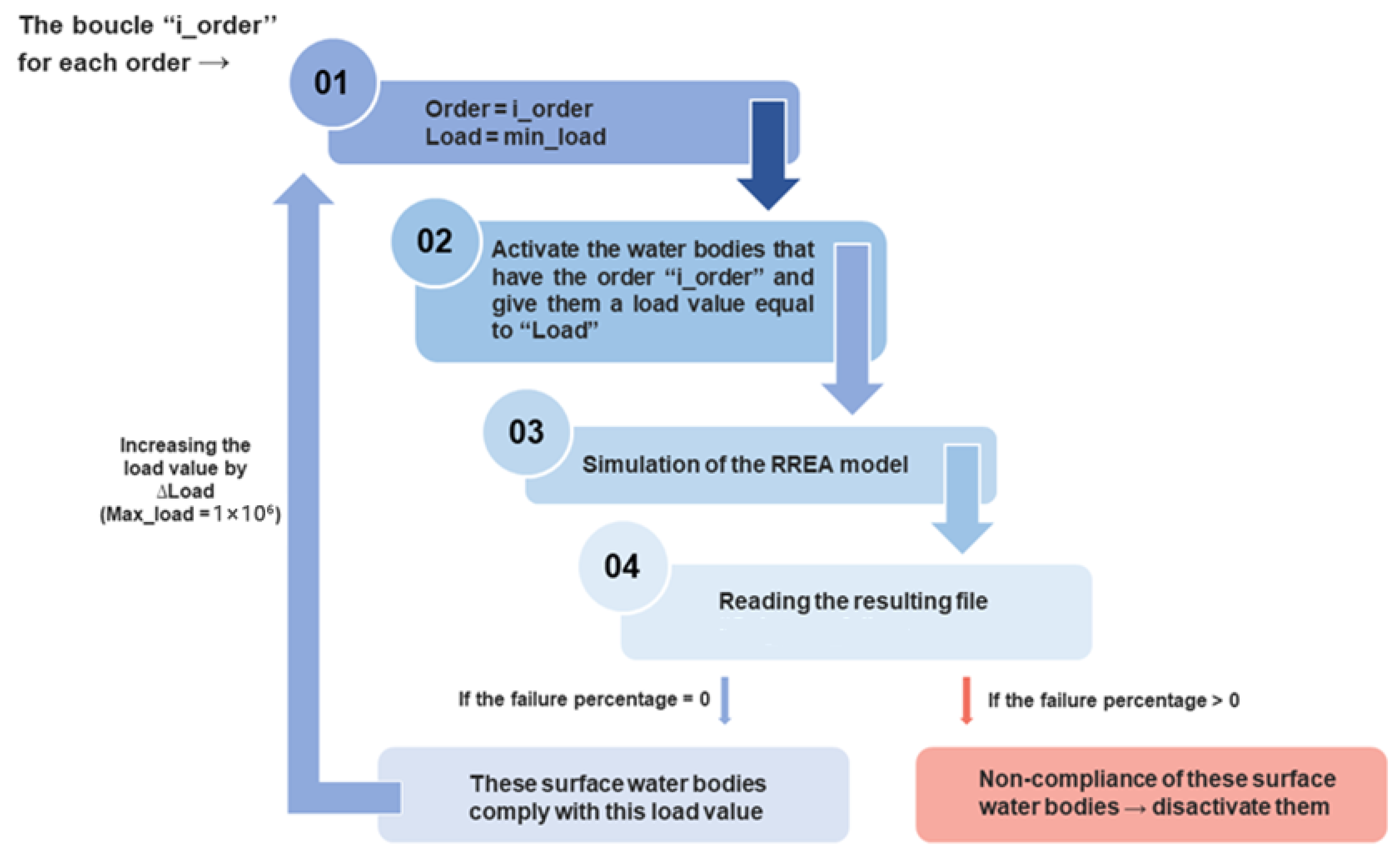
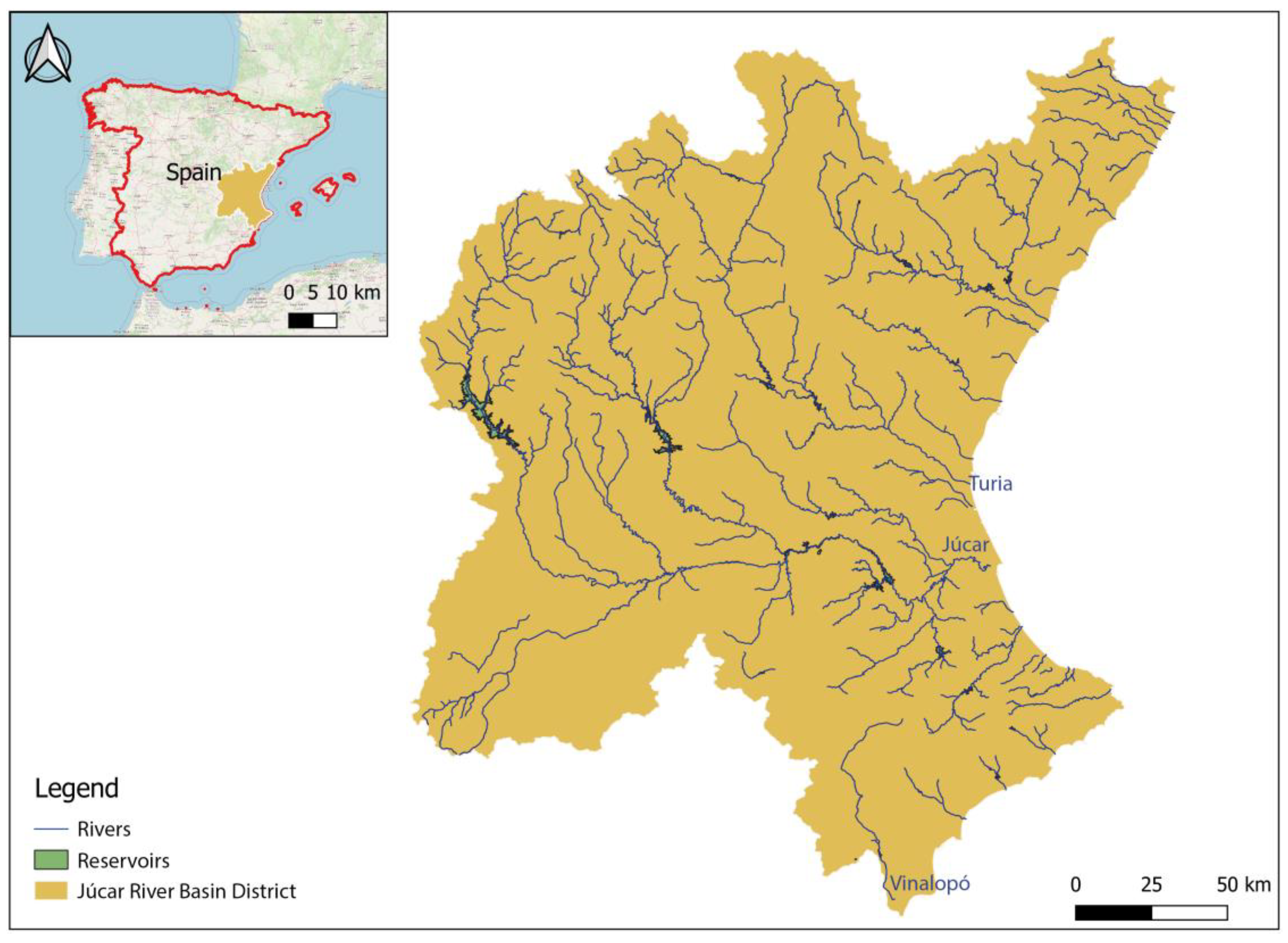
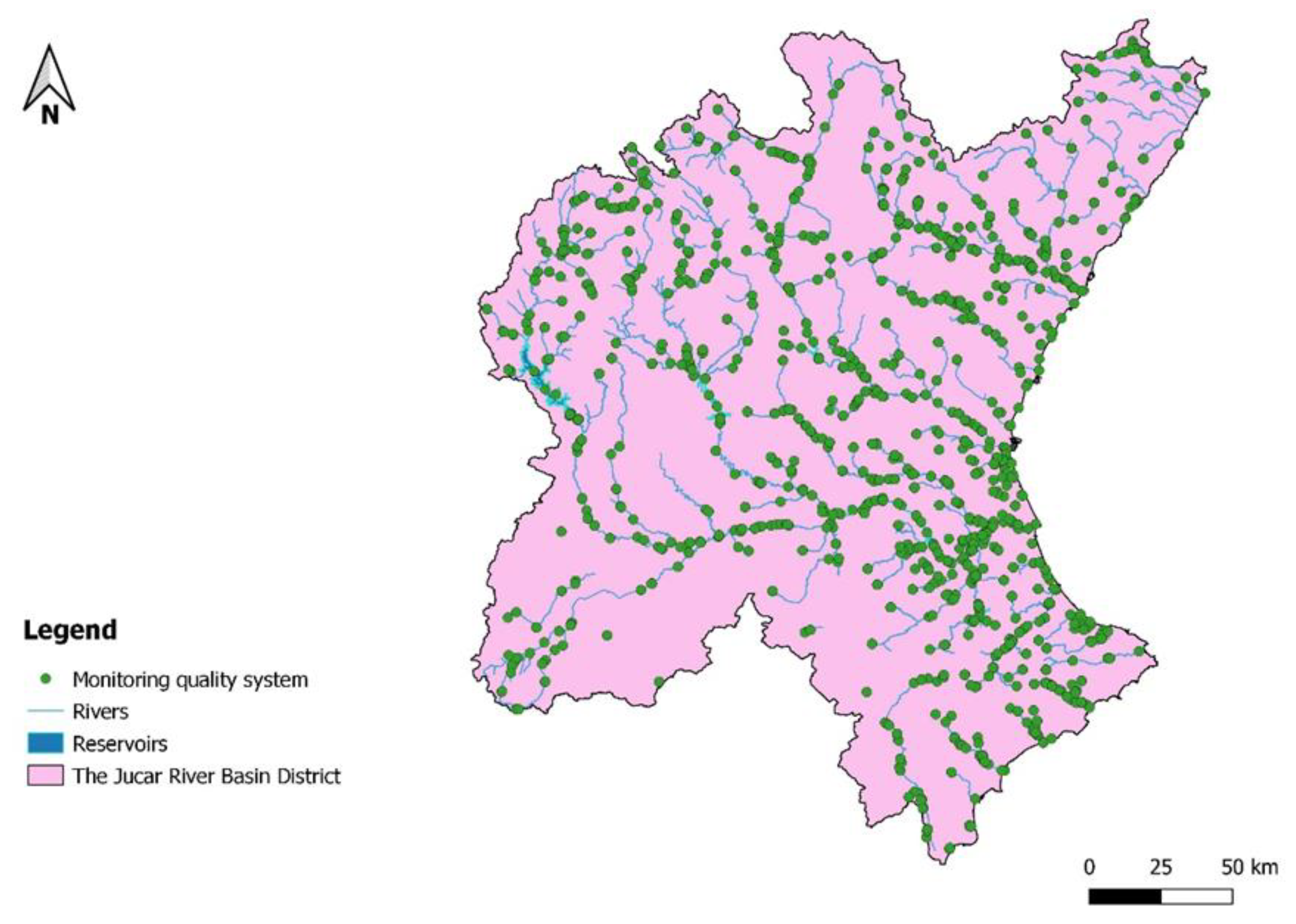

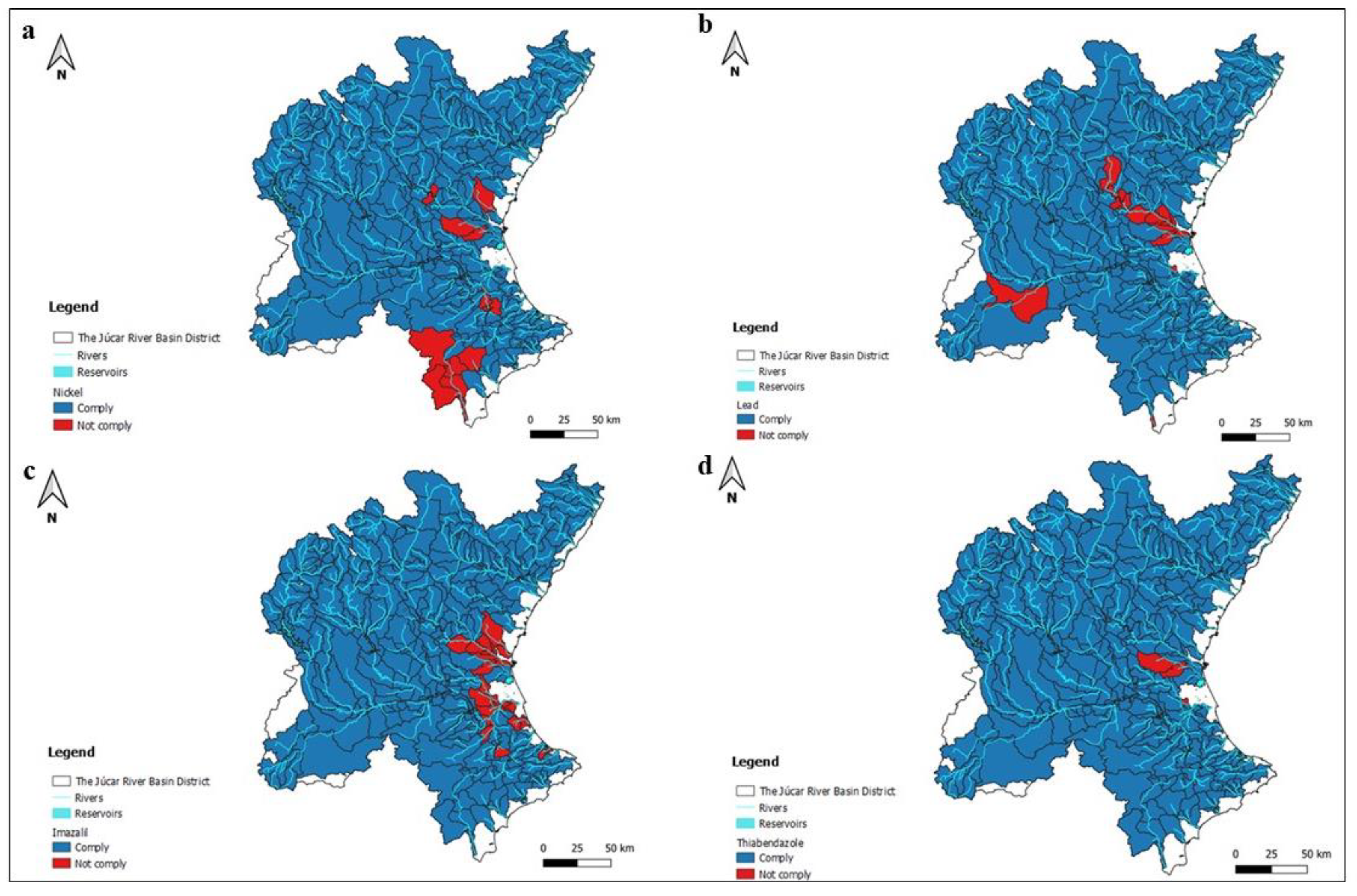

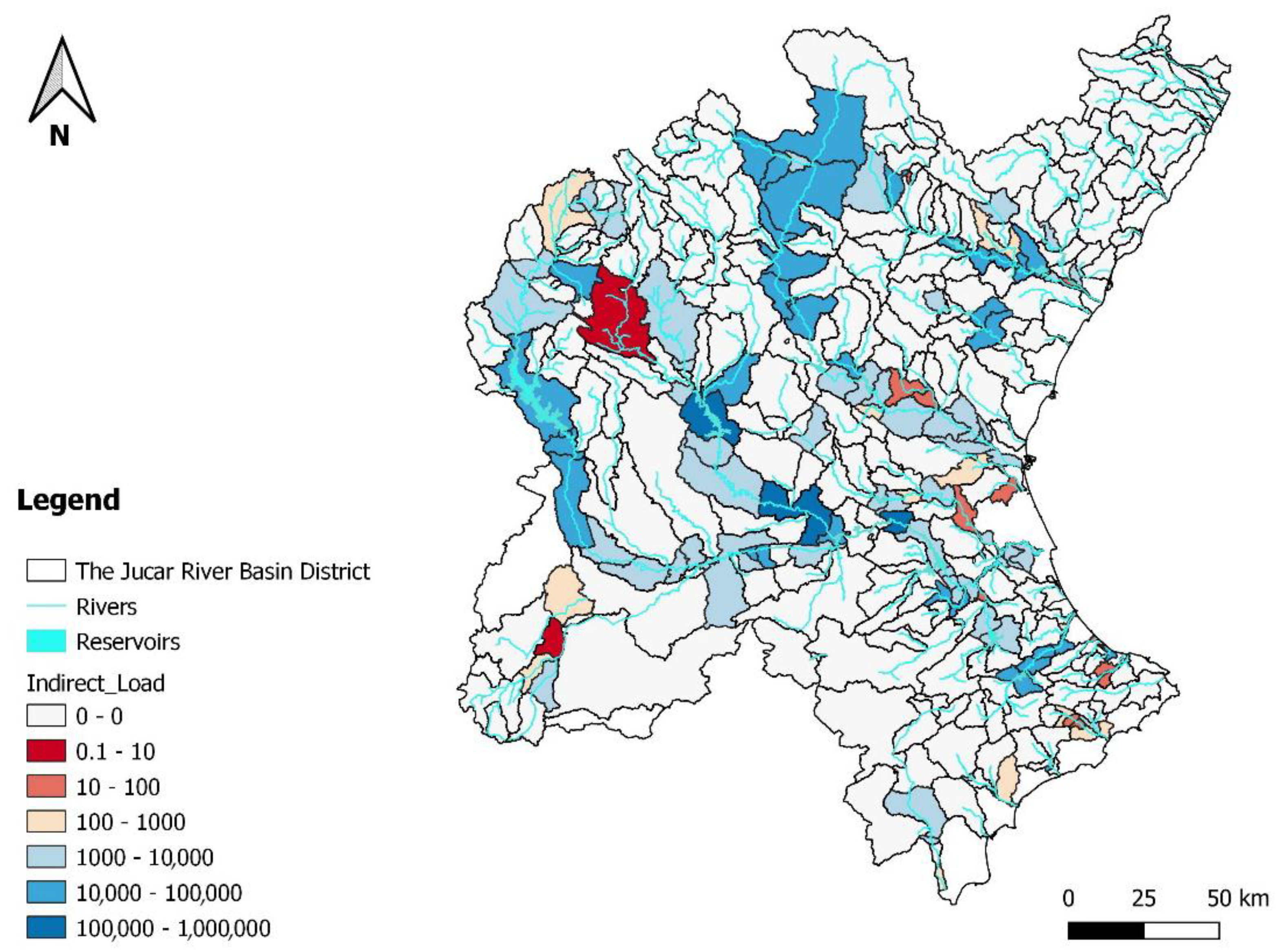
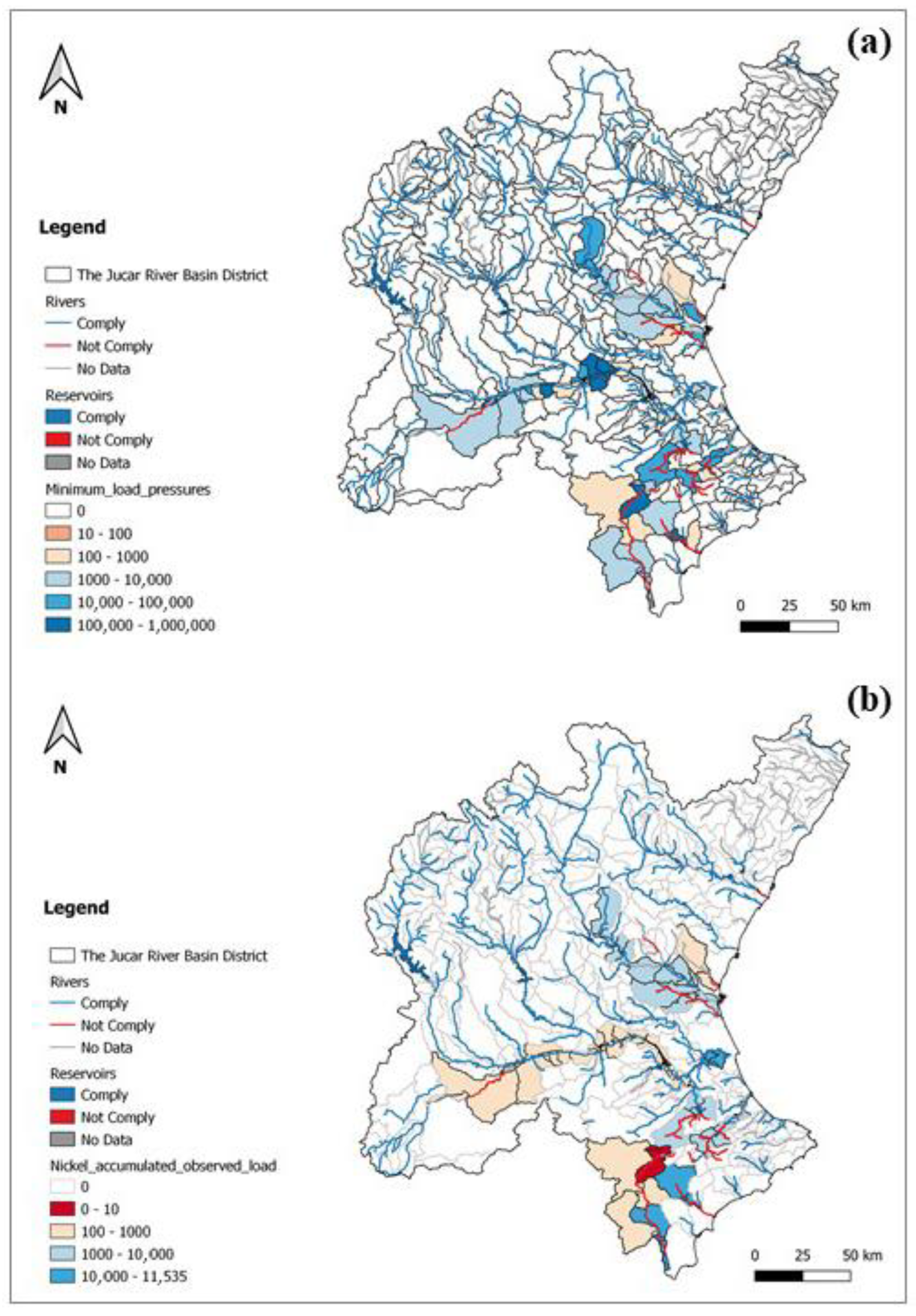
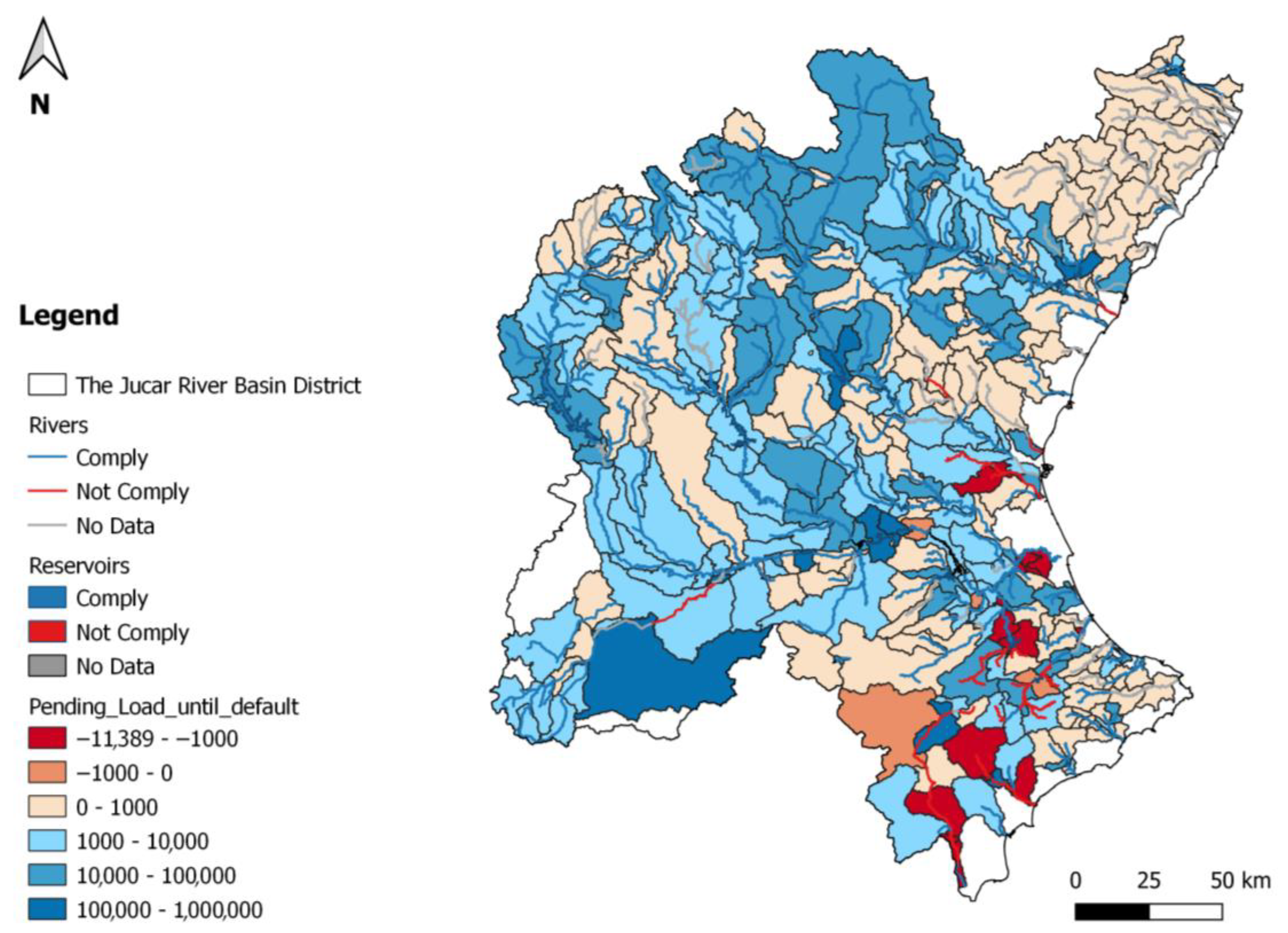


| Simulated | ||
|---|---|---|
| Observed | Current Accumulated Load > Minimum Non-Compliance Load | Current Accumulated Load < Minimum Non-Compliance Load |
| Compliance | Confidence level of compliance: Low | If the Current accumulated load < 50% of the Minimum load → Confidence level of compliance High |
| If the Current accumulated load is between 50–100% of the Minimum load → Confidence level of compliance Medium | ||
| Non-compliance | Confidence level of non-compliance: High | If the Current accumulated load < 50% of the Minimum load → Confidence level of non-compliance Low |
| If the Current accumulated load is between 50–100% of the Minimum load → Confidence level of non-compliance Medium | ||
| No data | Confidence level of compliance: Low | If the Current accumulated load < 50% of the Minimum load → Confidence level of compliance High |
| If the Current accumulated load is between 50–100% of the Minimum load → Confidence level of compliance Medium | ||
| Observations | ||||
|---|---|---|---|---|
| Comply | Not Comply | No Data | ||
| RREA results | Comply | 247 | 18 | 58 |
| Not comply | 4 | 13 | 1 | |
| Observations | ||||
|---|---|---|---|---|
| Comply | Not Comply | No Data | ||
| RREA results | Comply | 241 | 25 | 59 |
| Not comply | 12 | 4 | 0 | |
| Observations | ||||
|---|---|---|---|---|
| Comply | Not Comply | No Data | ||
| RREA results | Comply | 198 | 7 | 102 |
| Not comply | 16 | 15 | 3 | |
| Observations | ||||
|---|---|---|---|---|
| Comply | Not Comply | No Data | ||
| RREA results | Comply | 227 | 3 | 105 |
| Not comply | 5 | 1 | 0 | |
Disclaimer/Publisher’s Note: The statements, opinions and data contained in all publications are solely those of the individual author(s) and contributor(s) and not of MDPI and/or the editor(s). MDPI and/or the editor(s) disclaim responsibility for any injury to people or property resulting from any ideas, methods, instructions or products referred to in the content. |
© 2025 by the authors. Licensee MDPI, Basel, Switzerland. This article is an open access article distributed under the terms and conditions of the Creative Commons Attribution (CC BY) license (https://creativecommons.org/licenses/by/4.0/).
Share and Cite
Aydi, S.; Paredes-Arquiola, J.; Bergillos, R.J.; Solera, A.; Andreu, J. A Pressure-Impact Approach to Assess Contamination and Risk in Surface Water Bodies. Hydrology 2025, 12, 301. https://doi.org/10.3390/hydrology12110301
Aydi S, Paredes-Arquiola J, Bergillos RJ, Solera A, Andreu J. A Pressure-Impact Approach to Assess Contamination and Risk in Surface Water Bodies. Hydrology. 2025; 12(11):301. https://doi.org/10.3390/hydrology12110301
Chicago/Turabian StyleAydi, Siwar, Javier Paredes-Arquiola, Rafael J. Bergillos, Abel Solera, and Joaquín Andreu. 2025. "A Pressure-Impact Approach to Assess Contamination and Risk in Surface Water Bodies" Hydrology 12, no. 11: 301. https://doi.org/10.3390/hydrology12110301
APA StyleAydi, S., Paredes-Arquiola, J., Bergillos, R. J., Solera, A., & Andreu, J. (2025). A Pressure-Impact Approach to Assess Contamination and Risk in Surface Water Bodies. Hydrology, 12(11), 301. https://doi.org/10.3390/hydrology12110301







